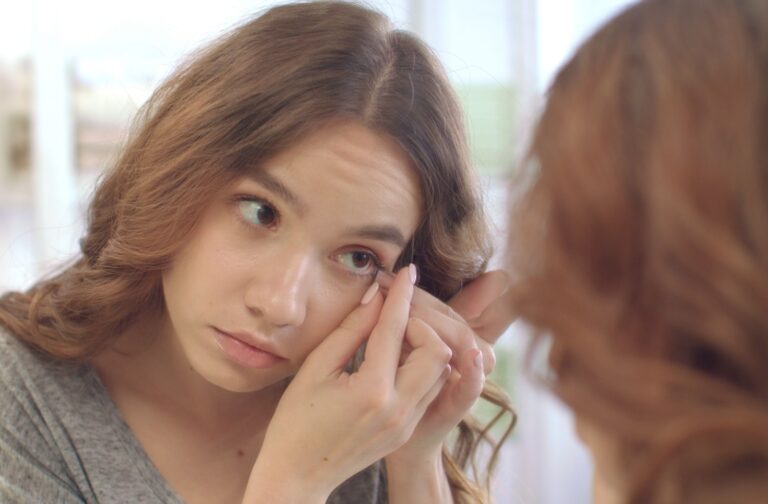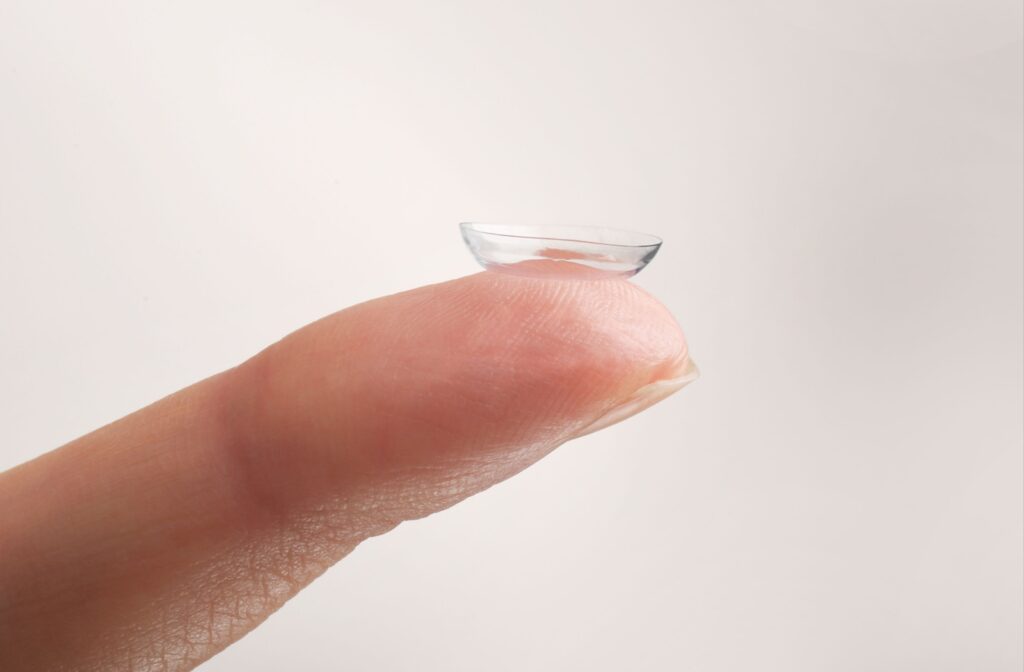Table of Contents

Introduction
If you deal with dryness and irritation in your eyes, you’re likely dealing with a condition called dry eye. This common condition is linked to an imbalanced tear film. Dry eye leaves the eyes exposed and inflamed, which can make everyday activities much more uncomfortable.
If you wear contact lenses, you may need to switch back to your glasses while dealing with dry eye symptoms. Because the lenses touch the cornea, they can cause further irritation. If you’d prefer contacts, you can always visit your optometrist to discuss specialty contact lenses for dry eye.
What Causes Dry Eye?
Your tear film is extremely important. It keeps your eyes protected from bacteria, debris, and dirt while giving a clear surface for light to pass through. However, it can sometimes struggle to fully protect the eyes. If it becomes imbalanced, it can leave the eye exposed to irritants.
When this occurs, it’s called dry eye. It’s extremely common and often feels like there’s sand trapped in your eye. You might notice inflammation, gritty sensations, and overall discomfort with dry eye.
This condition can develop due to:
- Environmental factors, like exposure to too much wind, smoke, or dry air
- Certain medications, including antihistamines, decongestants, and hormonal contraceptives
- Aging, as the eyes tend to produce less tears with age
- Medical conditions like autoimmune diseases, diabetes, and thyroid disorders
- Hormonal changes, such as those experienced during pregnancy or menopause
Eventually, one or more of these factors may affect the tear film. Your eyes may not produce enough tears, or they may produce tears that don’t fully protect the eyes. Either way, the result is the same—a stinging, burning sensation.
Dry Eye: What Are the Symptoms?
Dry eye isn’t about temporary discomfort. If you don’t address the problem, you’re leaving your eyes exposed to bacteria and debris. This increases the risk of long-term problems.
It helps to watch out for the early signs of dry eye. These include:
- Burning or stinging sensations that persist through the day
- Redness or an inflamed appearance around the eyes
- A gritty or sandy feeling, as if something is stuck in your eye
- Blurred vision and distortions around lights
If you notice these, it’s time to visit your optometrist.
Eye Dryness with Contacts
If you wear contacts and are dealing with dry eyes, you might have noticed they can be a frustrating combination. Contacts sit directly on your eyes. If you have dry eye, your eyes are already struggling to stay hydrated. Over time, contact lenses can absorb moisture from the surface of your eyes, leading to worse dryness.
This becomes more uncomfortable if you don’t properly take care of your contacts as well. Make sure that you always:
- Check the expiration date, as older lenses can irritate the eyes.
- Clean your lenses with fresh solution to remove debris and maintain moisture.
- Store your contacts in a clean, airtight case to keep them safe from contaminants.
- Keep your hands clean and dry before handling lenses to reduce irritation risks.
- Avoid sleeping in your contact lenses unless approved by your eye doctor.
If your lenses irritate your eyes, it may help to switch to your glasses while your symptoms recede. However, if you still prefer contacts over eyeglasses, you do have options.
Contact Lenses for Dry Eye
A popular choice that can help with dry eyes are specialty contacts like scleral lenses. These take a simple but efficient approach to treatment.
Unlike regular lenses that sit on the cornea, scleral lenses rest on the sclera—the white part of your eye. They arch over the cornea, leaving a small gap underneath. This design creates a space between the lens and your cornea that traps moisture.
This is particularly effective for dry eyes as it traps tears and a small amount of saline solution against the eye’s surface. This helps keep the eyes steadily hydrated, which reduces dry eye symptoms. Meanwhile, the larger size of the lens makes it less likely to irritate your eyes.

How to Treat Dry Eye
If you’re struggling to wear contact lenses due to dry eyes, visit your optometrist to try dry eye therapy. They can assess your tear film’s health and recommend a treatment that matches your needs.
They may recommend you begin with options like eye drops and warm compresses. These are a great way to find temporary relief, but depending on the severity of your symptoms, they may not offer lasting results. They’re designed to help reduce short-term symptoms when you need them.
Some people require a more advanced approach—like dry eye therapy.
What Is Dry Eye Therapy?
For serious cases of dry eyes, you can try an in-office dry eye treatment. Here at Golden Vision Optometry, we often recommend:
- Intense pulsed light (IPL): This is focused on reducing inflammation to improve the quality of your tears.
- LipiFlow: This treatment helps unclog blockages in tear glands, restoring natural tear flow.
- Low-level light therapy (LLLT): This is designed to stimulate overall gland health for better tear production.
- Gland expression: This removes blockages to improve the function of tear-producing glands.
Each of these treatments is noninvasive, quick, and effective. They offer lasting results to prevent future symptoms. Dry eye therapy is a great way to find lasting relief when your symptoms are persistent!

